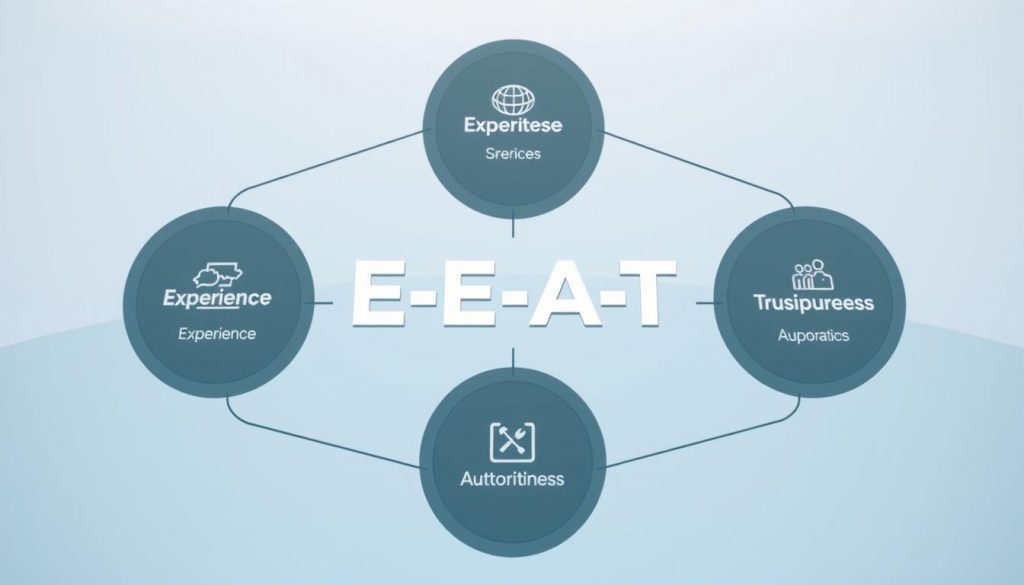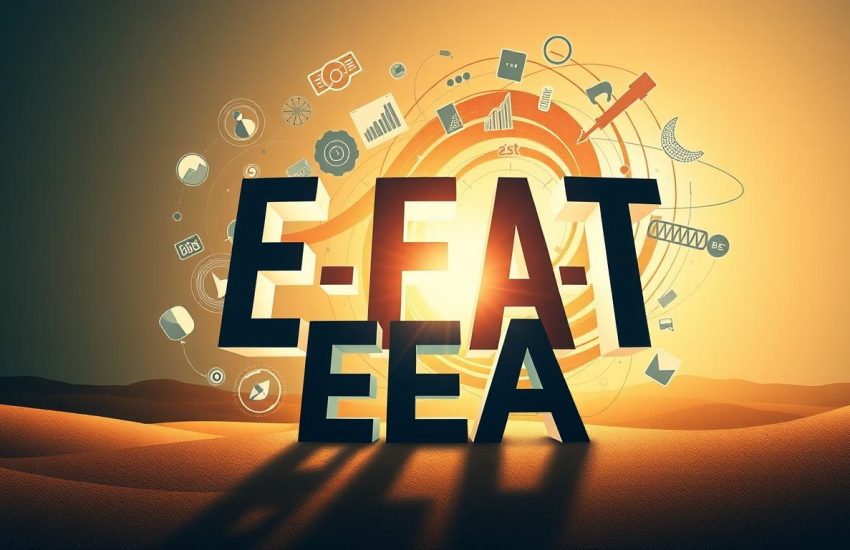Are you trying to make your content stand out online? Google’s algorithms keep changing, making it key to understand E-E-A-T in SEO for success.
We’re a top digital marketing agency. We know how important it is to create content that connects with your audience and meets Google’s standards. But what is E-E-A-T, and how does it boost your SEO?
E-E-A-T is more than a trend; it’s a way to make your content more believable and seen online. By focusing on Experience, Expertise, Authoritativeness, and Trustworthiness, you can get your site ranked higher. This brings more valuable visitors to your site.
Key Takeaways
- Understand the components of E-E-A-T and their role in SEO.
- Learn how to enhance your content’s credibility.
- Discover actionable tips to improve your website’s search visibility.
- Make informed decisions about your digital marketing strategies.
- Drive measurable business growth through data-driven SEO.
The Evolution of Google’s Quality Standards
Google has always been working to make search results better and easier to use. Over time, it has made big changes to how it checks and ranks content.
From PageRank to Quality Rater Guidelines
Google started with PageRank, which looked at links to rank pages. But as the internet grew, Google added Quality Rater Guidelines. This change made it clear that high-quality, relevant content is key.
The Shift from E-A-T to E-E-A-T
At first, Google used E-A-T (Expertise, Authoritativeness, Trustworthiness) to judge content. But in 2022, it added “Experience” to E-E-A-T.
Why Experience Was Added in 2022
Adding “Experience” shows that real-life experience makes content more credible and relevant.
| Year | Update | Focus |
|---|---|---|
| 2000s | PageRank | Link Equity |
| 2010s | Quality Rater Guidelines | Content Quality |
| 2022 | E-E-A-T | Experience, Expertise, Authoritativeness, Trustworthiness |

Understanding E-E-A-T: The Complete Framework
Google’s E-E-A-T framework is a detailed way to check content quality. It’s key for making content that Google likes and boosts your search ranking.
Experience: Demonstrating First-Hand Knowledge
Experience means showing you really know your stuff. Content makers should share their own experiences or those of their team to gain trust.
How Google Identifies Experiential Content
Google spots experiential content by looking at how personal it is. Adding real-life stories, case studies, and personal tales can make your content more relatable.
Expertise: Showcasing Subject Matter Knowledge
Expertise is about showing you know your topic well. Writing detailed author bios that show off your skills can make your content seem more expert.
Authoritativeness: Building Industry Recognition
Authoritativeness means being known in your field. Getting quality links from trusted sites and using expert advice can make your content seem more authoritative.
Trustworthiness: Establishing Credibility and Safety
Trustworthiness is about being reliable and safe for your readers. Using trust signals like clear contact info, legal pages, and HTTPS can make your content more trustworthy.
By getting these four parts of the E-E-A-T framework, you can make content that goes beyond Google’s standards.

Why E-E-A-T Matters for Modern SEO
E-E-A-T is key in SEO, affecting how visible your site is online. As Google updates its search rules, knowing E-E-A-T is vital for web owners and marketers.
E-E-A-T’s Influence on Google’s Ranking Systems
E-E-A-T is important for Google’s ranking. It checks if your content is trustworthy and reliable. Google looks at your site’s experience, expertise, and trustworthiness.
Correlation Between E-E-A-T Signals and Search Visibility
Websites with strong E-E-A-T signals rank better. A study showed that:
| E-E-A-T Signal | Average Ranking Improvement |
|---|---|
| High Expertise | +2.5 positions |
| Strong Authoritativeness | +3.2 positions |
| High Trustworthiness | +4.1 positions |
Case Studies: Websites That Gained or Lost After Algorithm Updates
Many examples show E-E-A-T’s effect on rankings. A health site boosted its E-E-A-T and saw more visitors. On the other hand, a site with poor E-E-A-T lost its ranking after an update.
By improving your E-E-A-T, you can boost your site’s visibility. This keeps you ahead in the changing SEO world.
YMYL Content: The High-Stakes E-E-A-T Battlefield
For topics under ‘Your Money or Your Life’, meeting E-E-A-T standards is key. YMYL content affects users’ lives, so strict guidelines are needed.
Defining Your Money or Your Life Topics
YMYL topics include health, finance, safety, and big life decisions. These areas need a lot of expertise and trust.
Health, Finance, Safety, and Major Life Decisions
Content about health advice, financial planning, safety, and big life choices is YMYL. For example, articles on investments or health supplements must be backed by solid sources and expertise.
The Stricter Standards for YMYL Content
Google has stricter E-E-A-T standards for YMYL content. This is because it can affect users’ well-being and finances. Creators must show top-notch expertise, authoritativeness, and trustworthiness.
John Mueller, a Google Search Advocate, said, “For topics that could significantly affect the user’s life or financial situation, we expect a very high level of E-A-T.” This advice is even more important now.
Strategies for Non-YMYL vs. YMYL Content Approaches
It’s important to know the difference between YMYL and non-YMYL content. For YMYL, focus on showing your credentials, citing reliable sources, and being accurate. Non-YMYL content can focus more on being engaging and fun.
| Content Type | E-E-A-T Focus | Key Strategies |
|---|---|---|
| YMYL | Expertise, Authoritativeness, Trustworthiness | Show credentials, cite reputable sources, ensure accuracy |
| Non-YMYL | Engagement, Entertainment | Focus on storytelling, use engaging visuals |
Practical Ways to Demonstrate Experience in Content
Creating effective content is more than just sharing facts. It’s about showing your skills and experience. By sharing your personal stories and examples, you connect with your audience and gain credibility.
Incorporating Personal Stories and Case Studies
Personal anecdotes and case studies make your content relatable and interesting. For example, if you’re discussing a tough topic, share how you solved it. This adds a personal touch and shows your real-world experience.
Documenting Processes with Visual Evidence
Visuals like images, videos, or infographics can make your points clear and engaging. By showing your processes and results, you prove your experience and knowledge.
Using First-Person Narrative Effectively
Writing in the first person can make your content feel more real and immediate. But, it’s key to keep a balance between your personal story and a professional tone.
Balancing Personal Experience with Professional Tone
To find this balance, use your personal experiences to highlight important points or add context. Keep your tone professional. This way, you build trust with your readers without seeming too casual or unprofessional.
How to Build Strong Expertise Signals
Building strong expertise signals is key to making your content more credible and visible online. Focus on areas that show you’re an expert in your field.
Creating Comprehensive Author Bios
A good author bio is vital for showing your expertise. It introduces you to your readers and proves your credibility.
Essential Elements Every Bio Should Include
- Professional Background: Share your relevant work experience and achievements.
- Education and Certifications: List any degrees, certifications, or training that support your expertise.
- Notable Contributions: Mention any big contributions to your field, like publications or awards.
As Rand Fishkin, founder of Moz, once said,
“The best content is created by people who are genuinely knowledgeable and passionate about their subject matter.”
This shows how important it is to show your expertise in your bio.
Showcasing Credentials, Certifications, and Education
Showing off your credentials and certifications can boost your expertise signals. You can do this in your bio, on an ‘About’ page, or in your content.
Developing Content Depth Without Overwhelming Readers
It’s important to show you know a lot, but also to make it easy for readers to understand. Break down complex topics into simple sections. Use clear headings and visual aids like diagrams or infographics.
By using these strategies, you can build strong expertise signals. This will make your content more credible and improve your search visibility.
Strategies for Establishing Authoritativeness
Building authority is a complex task that requires several steps. To be seen as an expert in your field, you must have a strong online presence. This presence should show your knowledge and trustworthiness.
Earning Quality Backlinks from Relevant Sources
Getting backlinks from trusted sites is key to building authority. These links are like recommendations for your content. To get these links, create high-quality, informative content that others will want to share. You can also write guest posts or be included in resource pages.
Leveraging Expert Contributions and Interviews
Using expert insights is another great strategy. By sharing industry expert opinions, you make your content more credible. This can be through interviews, guest posts, or webinars. Showcasing diverse perspectives helps you gain more authority with your audience.
Building Industry Partnerships and Mentions
Forming partnerships with industry leaders can boost your authority. This can include collaborations or mentions in publications. Industry partnerships show your peers trust you, increasing your credibility and visibility.
Getting Featured in Industry Publications
Being featured in industry publications is a powerful way to build your brand. It exposes your brand to more people and adds credibility. To get featured, create compelling, newsworthy content that publications will want. Building relationships with editors can also help.
| Strategy | Description | Benefits |
|---|---|---|
| Earning Quality Backlinks | Create high-quality content and participate in guest blogging | Increased credibility, improved SEO |
| Leveraging Expert Contributions | Feature expert insights through interviews or guest posts | Enhanced credibility, expanded network |
| Building Industry Partnerships | Collaborate with industry players through partnerships or mentions | Increased visibility, credibility |
Implementing Trust Signals That Strengthen E-E-A-T
Building trust with your audience is key to a better E-E-A-T score. Trust signals are important for credibility and a good user experience. Adding these signals to your site can boost your E-E-A-T and search rankings.
Creating Transparent About and Contact Pages
About and Contact pages are key trust signals. They give users important info about your site and its owners. Your About page should share your company’s mission, history, and team. Make sure your Contact page is easy to find and offers various contact options.
Developing Complete Legal Pages
Legal pages like Privacy Policies and Terms of Service are vital for trust and legal compliance. These pages should be clear, easy to find, and updated often.
Privacy Policies, Terms of Service, and Disclosures
Your Privacy Policy should explain how you handle user data. Terms of Service outline website rules. Disclosures are needed for transparency in affiliate marketing or sponsored content. Keep these documents short but detailed, and place them in your website’s footer.
Technical Trust: HTTPS, Security, and Data Protection
Technical trust is essential for E-E-A-T. HTTPS encrypts data between your site and users. Regular updates, strong data protection, and GDPR compliance are also key.
To show technical trust, consider these steps:
- Implement HTTPS and display trust badges
- Regularly update your software and plugins
- Use robust passwords and authentication methods
- Comply with data protection regulations
Social Proof: Reviews, Testimonials, and Case Studies
Social proof is a strong trust signal. It shows your site’s credibility through others’ experiences. Reviews, testimonials, and case studies boost your E-E-A-T by showing your expertise and value.
Here’s how different trust signals affect E-E-A-T:
| Trust Signal | E-E-A-T Impact | User Benefit |
|---|---|---|
| Transparent About Page | Establishes credibility | Users understand your mission and values |
| HTTPS and Security Measures | Demonstrates technical trust | Users’ data is protected |
| Customer Reviews and Testimonials | Provides social proof | Users see the experiences of others |
By using these trust signals, you can improve your E-E-A-T, gain user trust, and boost search rankings. Building trust is an ongoing effort that needs constant work and attention.
Content Creation Blueprint for Enhanced E-E-A-T
A well-structured content blueprint is key for boosting E-E-A-T and improving SEO. It focuses on several important elements. These elements work together to build a strong content strategy.
Research Methodology and Source Verification
Creating a solid research methodology is essential for high-quality, trustworthy content. You must verify sources through fact-checking and use credible references. This shows expertise and builds trust with your audience.
Content Maintenance and Update Protocols
Keeping your content up-to-date is vital for maintaining E-E-A-T. This means checking existing content for accuracy and relevance. You should also update it to keep information current.
Balancing Depth with Readability
It’s important to balance detailed information with easy-to-read content. Use clear, simple language. Break down complex topics into easy-to-understand sections.
Using Visuals to Support Complex Information
Adding visuals like charts, graphs, and infographics can make complex information easier to read. Visuals help explain the text and make your content more engaging and accessible.
By using these strategies, you can create a content blueprint that boosts E-E-A-T. This will improve both user engagement and search engine rankings.
Technical SEO Elements That Support E-E-A-T
Improving your technical SEO is key for a strong E-E-A-T strategy. E-E-A-T looks at your content’s quality and trustworthiness. Technical SEO makes sure your site is easy for search engines to find and use.
Implementing Author and Organization Schema
Schema markup for authors and organizations boosts your content’s credibility. You can do this by adding schema.org markup to your site.
- Add
authorandpublisherproperties to your content - Use
PersonorOrganizationschema to describe the author or publisher - Include relevant details like name, description, and URL
Optimizing Core Web Vitals for Better User Experience
Core Web Vitals measure your site’s user experience. Improving these metrics is essential for better E-E-A-T. They directly affect how users interact with your site.
| Core Web Vital | Description | Optimization Strategy |
|---|---|---|
| Largest Contentful Paint (LCP) | Measures loading performance | Optimize images, use lazy loading, and improve server response times |
| Cumulative Layout Shift (CLS) | Measures visual stability | Use aspect ratio for images and videos, avoid injecting content above existing content |
| First Input Delay (FID) | Measures interactivity | Minimize JavaScript execution time, optimize for user input |
Strategic Internal Linking for Topic Authority
Internal linking shows search engines your site’s structure and content order. By linking to relevant pages, you boost topic authority and E-E-A-T.
To link strategically, find key topics and create a hub-and-spoke model. Link related content together. This makes it easier for users and search engines to explore your site.
Common E-E-A-T Misconceptions and Challenges
Understanding E-E-A-T is key to avoiding common mistakes. Knowing these can help you improve your SEO without making costly errors.
E-E-A-T Is Not a Direct Ranking Factor
Many think E-E-A-T directly affects Google rankings. But, it’s more about the quality and trustworthiness of your content. Google looks at many factors, including E-E-A-T, when ranking websites.
Balancing E-E-A-T Requirements Across Different Industries
Each industry has its own E-E-A-T standards. For example, topics like YMYL need higher standards than others. Knowing these differences is vital for a good content strategy.
Overcoming Limited Experience or Credentials
Lacking direct experience or credentials doesn’t mean you can’t create good content. You can show E-E-A-T by using credible sources and doing thorough research. Being open about your limitations and focusing on accuracy can also build trust.
By tackling these E-E-A-T misconceptions and challenges, you can make your SEO better. This will help your content be more visible and trusted by Google.
Measuring and Monitoring Your E-E-A-T Progress
It’s important to track your E-E-A-T progress to improve your SEO. You need to look at key metrics, use the right tools, and do regular audits.
Key Metrics That Indicate E-E-A-T Improvement
Watch your organic traffic growth, search engine ranking positions (SERPs), and user engagement metrics. These show how well your content is doing and if your E-E-A-T efforts are working.
Tools for Tracking Authority and Trust Signals
Use tools like Ahrefs, SEMrush, or Moz to check your website’s authority and trust. These tools track backlinks, domain authority, and other important metrics for E-E-A-T.
Conducting Regular E-E-A-T Audits
Regular E-E-A-T audits check your content’s quality, relevance, and Google compliance. This helps find areas to improve and keeps your content up to E-E-A-T standards.
Creating an E-E-A-T Improvement Roadmap
To make an E-E-A-T improvement plan, first find out what you’re good at and what needs work. Then, set clear goals for bettering your E-E-A-T. Your plan should include ways to improve content, build authority, and increase trust.
Conclusion: Making E-E-A-T the Foundation of Your SEO Strategy
Integrating E-E-A-T into your SEO strategy is key for boosting your website’s credibility and visibility. It’s essential for improving your search performance. By focusing on E-E-A-T, you lay a strong foundation for long-term success.
To implement an E-E-A-T strategy, highlight your experience and expertise in your content. Use high-quality content and technical optimization. This means creating detailed author bios and using HTTPS for trust signals.
By doing this, you make your content more credible. This helps your website rank better in searches. Keep an eye on your E-E-A-T progress with key metrics and audits. This will help you spot areas to improve and adjust your strategy.
By making E-E-A-T a central part of your SEO, you build a strong online presence. This presence attracts both users and search engines, leading to sustainable growth and measurable results.


